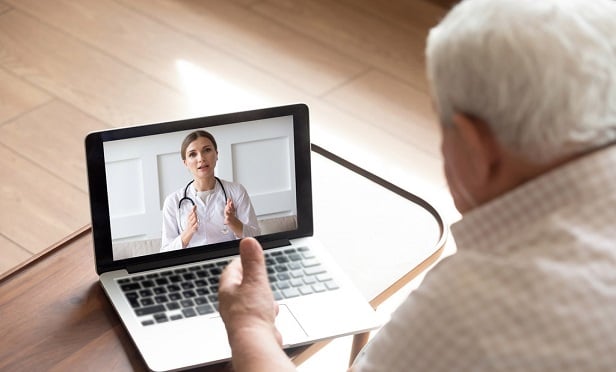 Telemedicine is a convenient alternative totraditional medical visits because it gives the worker anopportunity to engage with a medical provider with minimaldisruption. (Photo: Shutterstock)
Telemedicine is a convenient alternative totraditional medical visits because it gives the worker anopportunity to engage with a medical provider with minimaldisruption. (Photo: Shutterstock)
Telemedicine has grown more popular over the past few months asphysicians utilized new methods to connect with and diagnose theirpatients in the wake of the COVID-19 shutdowns. However, evenbefore these changes became necessary, many employers and medicaloffices found that virtual appointments delivered anotheralternative to providing care for some patients.
|Physicians, nurses and other medical personnel can triagepatients and the care they require, provide follow-up treatment asneeded, and identify complications requiring further attention. Forinjured workers, this type of support can expedite their recoveryand the ability to resume their responsibilities.
|Related: Worker's comp recovery in a COVID-19 world? Itdepends!
|"When an injured employee suffers a serious or complex injury,nurses can be a valuable resource to promote recovery and return towork," says Jennifer Cogbill, vice president, GBCARE at GallagherBassett. "What has changed during the COVID-19 pandemic is hownurses engage with the employee. With the disruption in traditionalmedical care, we've seen surgeries postponed or canceled. Physicianvisits and physical therapy have either been postponed or moved tovirtual visits. This can significantly impact recovery and delayreturn to work. In addition to attending virtual or telephonicvisits with providers, nurses also provided critical support byoffering alternative strategies for recovery and ensuring theworker is physically ready for surgery when we return tonormal."
|At your service
There are a wide range of medical services that can be providedremotely from kiosks in airports and pharmacies that allowindividuals to check their pulse, blood pressure, temperature andother vitals to triaging care through telehealth visits. In thesecases, nurses usually serve as the gatekeepers who determine whatlevel of care is required for a patient, from a bandage tosomething more serious.
|Dave Lupinsky, vice president of medical review services atCorVel Corporation, which provides health care management servicesfor employers, third-party administrators, insurers and governmententities, finds that care management starts by assessing whichlevel of care is required: self-care that patients can provide tothemselves with guidance from a nurse or other service provider,telecare provided remotely or care in a traditional brick andmortar location such as an emergency room or occupational clinicfor more serious situations.
|Within the CorVel system, Lupinsky says their caregivers havethe same tools as traditional doctors' offices. "We wanted them tohave access to the same services such as ordering physical therapy(PT)." Even virtual physical therapy is an option now. Whilephysical therapists provide excellent hands-on care to patients,there are benefits to virtual PT. "Patients don't have to travel,physical therapists have a high level of expertise and they are notbound by geography," details Lupinsky. Active modalities mayinclude exercises or stretching for patients.
|Lupinsky stresses that it's important to have candidconversations with patients about what they can realisticallyexpect from their care. "We want them to take more control of thesituation and get them moving again outside of the medication orprocedures they've had."
|For most patients, the visits are conducted either over adesktop computer or some sort of mobile device (e.g., cell phone ortablet). "There is less chance of contracting a communicabledisease, shorter wait times, the visits are more efficient andthere is a better opportunity for real-time monitoring of patientswith chronic illnesses because they can communicate regularly withtheir doctor's office," explains Kari Williamson, the CEO of MKCMedical Management, Inc. "Additionally, injured parties in remotelocations could benefit from some level of medical assessment…andpatients could conceivably have access to specialists, no matterhow remote."
|Telehealth visits can also save travel time, parking and otherexpenses for workers while limiting the amount of time they need totake away from their jobs, cites Lori Ilgenfritz, account principalwith Gallagher Bassett's transportation practice. For workers whotravel a lot such as sales professionals or truckers, telemedicineallows them to access treatment regardless of their location.
|"Telemedicine is a convenientalternative to traditional office visits for minorinjuries, after-hours and re-checks when traditional care isdisrupted, whether for COVID-19 or a natural disaster," finds BobEvans, director of GBCARE Networks for Gallagher Bassett. "It givesthe injured worker the ability to engage with a medical providerwhile on the road with minimal disruption. All that is needed is aninternet connection."
|In addition to flexible scheduling for appointments and theoverall convenience, Lupinsky says it is possible to use a small,niche group of physicians for telemedicine. "You can select thebest doctors in a wide geographical area to provide care." He alsoadded that some practices provide Spanish-speaking sites and nurseswho speak multiple languages, allowing workers to converse in theirnative tongue to ensure a clear understanding of the symptoms andcare required. Physicians must also be licensed in the state wherethe patient is located to provide care.
|For injured workers, early assessments and triaging the carerequired can be very helpful, acknowledges Williamson. "The earlyassessments allow for the employer to assist with management andinitiate internal protocols. It also sets a positive rapportbetween employer and employee, who are working together towardrecovery."
|Despite the convenience tele-visits provide, some very reallimitations must be considered. Some patients may not be technologysavvy and have trouble accessing the patient portal or gettingtheir computer to operate correctly (i.e., turning on the camera ormicrophone). "Low-grade equipment or a poor internet connection maycause miscommunication between parties," acknowledges Evans."Telemedicine also is not applicable for all injury and treatmenttypes due to the limitations with the exam and other servicesneeded."
|Speaking through a computer can also make it more difficult todevelop a rapport or have any sort of meaningful engagement with apatient.
|"Telemedicine will never completely take the place of hands-onvisits and care," stresses Williamson. "It may not be appropriatefor pediatric patients, especially for babies. Children and teensmay not give their full attention to the provider. Also,psychological/psychiatric care will have different challenges,especially during acute episodes. Reading or assessing bodylanguage, ambulation, range of motion, tone of voice could all benegatively impacted."
|One factor that could be affected by telemedicine involvesprescribing medications. How does the physician assess the properdose and is there a danger of under- or over-prescribing?Prescription renewals would be easier because there are less likelyto be adverse effects from existing medication.
|False telemedicine claims
Another issue to consider is telemedicine fraud. Protectingpatient information and confidentiality is a major issue,particularly since home networks tend to be more vulnerable becausecomputer users do not practice the same level of cybersecurity theydo in their offices. Physicians offering telemedicine also have tomake sure they use a platform that complies with HIPPA regulationson security, and they must observe state laws about recording callsand conversations.
|As telemedicine moves from a niche service to more mainstreamuse, the value in terms of insurance and workers' compensationclaims will grow exponentially. James Quiggle, senior director ofcommunications for the Coalition Against Insurance Fraud,anticipates that a new surge of tele-scams could well becomeAmerica's next large surge of medical fraud.
|"Workers' comp, auto and health insurers could find themselvesconfronting surges of false telemedicine claims. Insurers in eachline have a unique vulnerability due to the large volume of medicalclaims," he asserts. "Scams focus on exams, tests and treatmentsthat don't require physical contact — often abusing telemed codes.Many scams will be familiar, only using telemed as the frauddelivery vehicle. Providers might do dozens of perfunctory,two-minute, tele-consults to see if a patient is injured and needsphysical therapy. Doctors bill insurers for one-hour sessions andreceive kickbacks for referring patients to the physicaltherapist."
|Quiggle is concerned that insurers not familiar withtelemedicine may not recognize the red flags or billing codes thatcould be indicative of tele-scams, let alone actually investigatethem. "Insurers must know the telemedicine codes well," he urges."They're the gateway to bogus tele-billings."
|"Large crime rings will profit mightily from telemedicine.Telemarketing firms can hire phone boiler rooms to tele-recruithundreds of bogus patients. The patients are referred to colludingproviders for bogus tele-consults and treatment," he says,outlining how the fraud process will develop. "Even tele-pharmaciesmight take bogus prescriptions for expensive and unneeded compoundmeds or painkillers. Everyone feasts off of kickbacks and inflatedclaims. It's a familiar crime, although it abuses telemedicineinstead of traditional brick-and-mortar medicine." Soft tissueinjuries such as whiplash could also be easy prey for telemedicinescammers.
|Quiggle sees telemedicine redefining health care as we knowit today. "Patients will prefer the convenience of receiving muchof their health care in their living room instead of spending halfa day going to the doctor's office. A generation of digitalnatives — 80 million millennials — will wanttelemed. Insurers will have to offer robust telemed as acompetitive benefit to attract patients."
|However there will be a significant downside to the explosivegrowth of telemedicine, predicts Quiggle. "Dishonest medicalproviders and crime rings will follow the telemed money trail.They'll launch tele-scams that become America's next large surge ofmedical fraud."
|Additionally, Quiggle believes that large medical rings willlikely try to exploit the workers' comp system. In many cases,rings are already defrauding insurers with what he describes as'industrial-level' claims for unneeded, inflated or phantomtreatments. "Telemedicine will be another opening to try to defraudworkers' comp insurers."
|Preventing claims abuse
Insurers can take practical steps to prevent telemedicine fraud.Knowing the actual codes will be critical in identifying falseclaims. It is also vital that they be aware of the rules,regulations and laws for each state. The state medical boardsapprove these regulations and there will be differences toconsider. "Know the limits of reimbursable telemedicine in eachjurisdiction and how it has expanded," advises Quiggle. "Adjustyour analytics to spot anomalies in telemed billings and developmodels of telemedicine claims that you'll reimburse and contest.Determine your acceptable claim types, cost, frequency andseverity."
|He also recommends conducting a detailed threat analysis tolearn about tele-fraud exposures and suggests trying to slip fakeclaims through the system to see if they can be identified andwhere there are gaps. Staff training will also be crucial foridentifying potential fraud schemes. This includes specialinvestigative units, claims adjusters, managers and others.
|The convenience of telemedicine, the positive impact it can haveon employees' care and expediting their return to work, plus itscost-effectiveness are just several reasons why it is here to stay.Williamson says it is also possible it could be expanded forinterdisciplinary conferencing, particularly for complex injuriesand illnesses.
|While not a panacea, telemedicine does provide another tool formedical professionals to connect with patients, particularly in atime when social distancing seems prudent. However, like everyaspect of new technology, it needs to be implemented wisely.
|Patricia L. Harman ([email protected]) is theeditor-in-chief of Claims Magazine.
|Related:
Complete your profile to continue reading and get FREE access to BenefitsPRO, part of your ALM digital membership.
Your access to unlimited BenefitsPRO content isn’t changing.
Once you are an ALM digital member, you’ll receive:
- Critical BenefitsPRO information including cutting edge post-reform success strategies, access to educational webcasts and videos, resources from industry leaders, and informative Newsletters.
- Exclusive discounts on ALM, BenefitsPRO magazine and BenefitsPRO.com events
- Access to other award-winning ALM websites including ThinkAdvisor.com and Law.com
Already have an account? Sign In
© 2024 ALM Global, LLC, All Rights Reserved. Request academic re-use from www.copyright.com. All other uses, submit a request to [email protected]. For more information visit Asset & Logo Licensing.








